Variants vs Vaccines
Tagged:COVID
/
PharmaAndBiotech
/
Politics
SARS-CoV-2 is mutating, in increasingly dangerous ways. Can we keep up with booster vaccines for the variants, or even eliminate it once and for all?
SARS-CoV-2 virus variants
You hear all sorts of things about SARS-CoV-2 variants, with funny names like “B.1.1.7”, and “B.1.351”. People just refuse to learn what those names mean, and mostly don’t even pronounce them correctly (e.g., as though the periods weren’t there and didn’t mean anything worthy of their attention – a quick look through the phylogenetic tree below will explain that). But dangerous variants are real: they’re cropping up all over the place. From Public Health England, via an article in The Economist of all places [1], comes a nice graphic showing the phylogenetic tree of how the viruses evolved from their ancestral viruses (2019 - 2021):
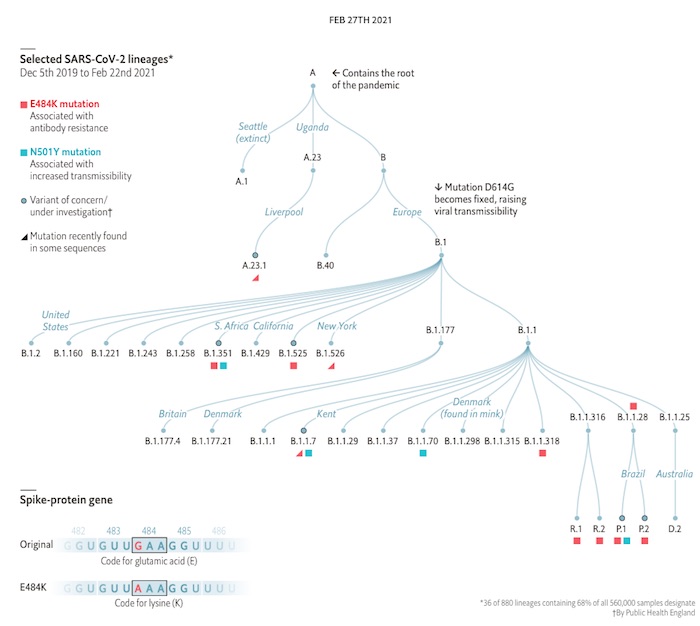
- The “A” series is the root of the tree, the strain that started the pandemic.
- It soon carves off a “B” branch, where the D614G mutation becomes ‘fixed’: present in just about everything thenceforward, because it confers a transmission advantage on the virus. (Mutation notation: this means that at position 614 in the protein, replace the normally found amino acid D (aspartic acid) with G (glycine). The amino acids all have single-letter codes.)
- Also tracked are 2 specific mutations: E484K in red (increases resistance to antibodies) and N501Y in blue (increases transmission). Both are bad news.
- Note the variants that have both the bad news mutations: B.1.351 (South Africa), P.1 (Brazil), and sometimes B.1.1.7 (Britain). That’s why you hear so much about these variants and not all the others, bad as the others may be: these guys are arming up to be more infective and evade immune response (natural or vaccine-induced).
- Because everything has to have an abbreviation nowadays, lest we actually communicate in words like our primitive ancestors, the variants B.1.1.7, B.1.351 and P.1 are VoCs (“Variants of Concern”). It’s more serious than it sounds.
Why are the so many variants? Actually, there are even more than the 38 variants shown in the tree: something like 880 known so far, according to the legend in the lower right. These are just the ones that have occurred frequently enough to be really, really annoying.
Initially, I thought there wouldn’t be very many variants: any mutation in the spike protein would probably make it bind less well to ACE2, and be competed away. Stupid me: nature found ways to bind to human ACE2 even better. The virus is evolving away from its bat origins and learning to specialize in predation on humans. We should expect a couple new, more-effective, mutations to flare up each month until we vaccinate substantially everybody. We need to vaccinate faster than our current glacial pace, and we need to do it world-wide, including the developing world!
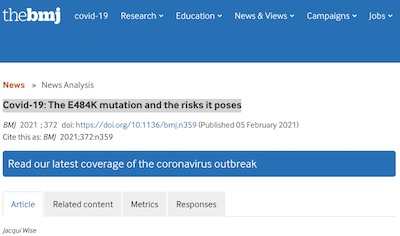 The current evidence, from the BMJ news analysis [2] shown
here, is that the E484K variant requires much, much higher concentrations of antibodies to
stop it. Vaccine efficacies are lowered (the currently still-experimental Novavax goes
down to 60%, but that’s still comparable to your annual flu vaccine, i.e., good enough to
be very worthwhile).
The current evidence, from the BMJ news analysis [2] shown
here, is that the E484K variant requires much, much higher concentrations of antibodies to
stop it. Vaccine efficacies are lowered (the currently still-experimental Novavax goes
down to 60%, but that’s still comparable to your annual flu vaccine, i.e., good enough to
be very worthwhile).
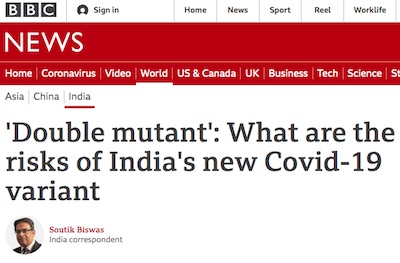 Just to convince you further, a BBC article [3] points out
that in India there is a new ‘double mutant’: E484Q and L452R. The E484Q is similar to
the E484K, and is another way of enhancing immune evasion. The L452R mutation is like the
“California variant” seen in the US, which is more transmissible.
Just to convince you further, a BBC article [3] points out
that in India there is a new ‘double mutant’: E484Q and L452R. The E484Q is similar to
the E484K, and is another way of enhancing immune evasion. The L452R mutation is like the
“California variant” seen in the US, which is more transmissible.
Expect this to continue, until vaccination is near-universal. This includes the developing world, as the India example shows here.
mRNA vaccines and boosters for variants

 Fortunately, once you have an mRNA vaccine (and its lipid nanocapsule, and the
preservatives, and the infrastructure, and… “stuff”), it’s relatively easy (i.e.,
difficult, but not skull-breakingly difficult) to replace the mRNA with a variant, or
possibly a mixture of variants. The mRNA vaccines are sometimes called “digital” because
of this: you reprogram your mRNA synthesizers, fiddle with stabilization mutations and
such, and you can quickly get out a variant vaccine candidate.
Fortunately, once you have an mRNA vaccine (and its lipid nanocapsule, and the
preservatives, and the infrastructure, and… “stuff”), it’s relatively easy (i.e.,
difficult, but not skull-breakingly difficult) to replace the mRNA with a variant, or
possibly a mixture of variants. The mRNA vaccines are sometimes called “digital” because
of this: you reprogram your mRNA synthesizers, fiddle with stabilization mutations and
such, and you can quickly get out a variant vaccine candidate.
Moderna has already started this [4], especially for the worrisome B.1.351 variant with immune escape potential. Unsurprisingly, Pfizer & BioNTech have done so as well. [5] If we assume something like a March start date and a 6 month clinical trial, that means they would be before the FDA in September.
What about the FDA?
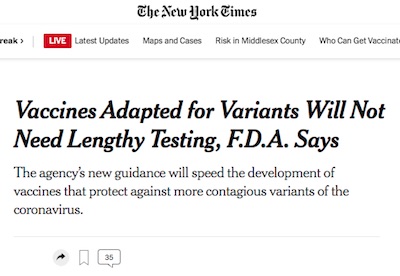
 Ok, “before the FDA”. Will there be a long delay there?
Ok, “before the FDA”. Will there be a long delay there?
Keep in mind, the usual FDA procedure is to throw out your conclusions, re-analyze your data using the methods specified in the clinical trial protocol, compare their results with yours, make a recommendation to an expert review committee, have the committe meeting, and then decide. Normally this takes time. The recent vaccine approvals have been lightning-fast, in that they could execute all of that in just a few weeks.
Will they continue that responsibly fast review? All signs point to yes, as indicated by these articles from the NYT [6] and Reuters. [7] This means the trials required will not be the monsters required the first time around, but rather more like the annual flu vaccine. This is completely appropriate for a vaccine whose general behavior is well understood, and is being tweaked to accomodate viral variants (exactly the case for influenza).
So that, at least, seems to be trending in the right direction. If the variant mini-trials read out in September, we might see variant booster vaccines available in October. Just in time for winter, like flu vaccines.
What about vaccine resistance?
Yeah, what about the vaccine resisters? They’ll be the demented knuckleheads they’ve always been. Maybe more: yet another variant will almost certainly make them scream “I told you so”… though exactly what they allegedly told us will remain vague.
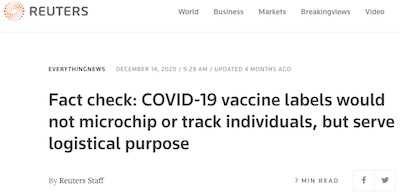 And the conspiracy theories will become more floridly psychotic. For example,
consider the arrant nonsense that the COVID-19 vaccines will inject you with a
microchip [8], so that Bill Gates or George Soros or
somebody will be able to… something.
And the conspiracy theories will become more floridly psychotic. For example,
consider the arrant nonsense that the COVID-19 vaccines will inject you with a
microchip [8], so that Bill Gates or George Soros or
somebody will be able to… something.
One enterprising vet has helpfully provided pictures of the hypodermic needles used to inject tracking chips into pets (such as happened to the Weekend Publisher; I rather imagine he did not approve of the experience) vs the needles used for vaccinations. The latter is a 22-25 gauge needle that you can barely feel; the former is by comparison giant:
The social engineering question is: how do we stop people from filling their heads with crap like this? Clearly, whatever we’ve been doing so far isn’t really working well enough!
The Weekend Prediction
By fall 2021, there will almost certainly be problems with new variants, possibly even beyond the B.1.1.7, B.1.351, and P.1 variants that bother us now. Some of them may have escape mutations, rendering previous vaccinations less useful (though not completely). Consequently, there will almost certainly be booster vaccines as the final path to eliminating COVID-19 as a pandemic. We will be weary of it all, and some will be suspicious of yet another vaccine for stupid reasons. But it will be important to take the booster and get it out to substantially all of humanity, or COVID-19 variants will never go away.
Get the booster if & when it comes.
That’s the answer to the question posed above, as to whether we can eliminate COVID-19 once and for all. Yes, if we vaccinate much faster and then get near-universal uptake of a booster to account for the variants that will accumulate in the meantime. Take a look again at the phylogenetic tree above. See that variant A.1 in the upper left corner? It’s labelled “extinct” in human. That’s what we want.
If we do not do that… get ready for ‘endemic COVID-19’ that hangs around forever, requiring a new vaccine every fall just like influenza.
I prefer the future with SARS-CoV-2 extinct in human. You should, too.
Addendum 2021-Apr-03


 It appears there is some good news on the viral variants front: Reuters is
reporting [9] that in patients convalescent from “classic”
COVID, T cell responses to the new variants are still strong.
It appears there is some good news on the viral variants front: Reuters is
reporting [9] that in patients convalescent from “classic”
COVID, T cell responses to the new variants are still strong.
Recall that immunology is, to say the least, complex. We know that neutralizing antibody responses from “classic” COVID are a bit weaker on some of the variants, particularly on the South African variant B.1.351. However, that’s only part of the story. We also want to know how long memory B cells remember the infection, and how aggressively T cells will hunt down and kill infected cells. This latest result implies that a vigorous T cell response against the new variants is present.
In an example of somewhat useless journalism, that’s all they say: no citation of the research beyond mentioning the first author’s name & affiliation, Andrew Redd of NIAID. So I had to dig a bit, and found the NIH news release [10], which fortunately had a bit more detail.
Among those details was the all-important pointer to the original paper [11], whose conclusions we can now analyze a bit.
- They took blood samples from n = 30 patients, each PCR-confirmed to have had COVID-19 and now convalescent. This captures not just antibodies, but circulating immune cells.
- They isolated PBMCs (peripheral blood mononuclear cells) to get hold of some CD8+ T cells, one of the hunters who seek out and kill infected cells.
- They tested T cell activity in a variety of complicated ways against the British variant (B.1.1.7), the South African variant (B.1.351) and the Brazilian variant (B.1.1.248). The latter is related to the P.1 variant of concern in some way I haven’t entirely understood, but apparently it covers the case of P.1.
- In each case, a strong T cell reaction against each viral variant was observed.
- Note that these T cells were trained on “classic” COVID-19, so the cross-reactivity with the variants is good news: it means immunity from classic COVID-19 (and presumably the vaccines designed against it) is likely to persist against the variants.
- Even though some of the mutations make neutralizing antibodies less likely to recognize the mutated spike protein, the T cells are apparently not fooled.
- However, they sound a cautionary note: the exact levels of antibody and T cell response needed to confer immunity is not known, they just note that it’s been observed.
So… that’s good news.
I’m still an anxious, depressed, cranky old scientist though: still betting (probability ~ 60%) that a booster will be necessary in the fall of 2021.
Notes & References
1: Public Health England graphic, “The same covid-19 mutations are appearing in different places”, The Economist, 2021-Feb-27. ↩
2: J Wise, “Covid-19: The E484K mutation and the risks it poses”, BMJ 2021, 372:n359. ↩
3: S Bisas, “‘Double mutant’: What are the risks of India’s new Covid-19 variant”, BBC News, 2021-Mar-25. ↩
4: Reuters Staff, “Moderna begins testing next-generation coronavirus vaccine”, Reuters, 2021-March-15. ↩
5: Pfizer, “PFIZER AND BIONTECH INITIATE A STUDY AS PART OF BROAD DEVELOPMENT PLAN TO EVALUATE COVID-19 BOOSTER AND NEW VACCINE VARIANTS”, Pfizer press releases, 2021-Feb-25. ↩
6: N Weiland, K Thomas, C Zimmer, “Vaccines Adapted for Variants Will Not Need Lengthy Testing, F.D.A. Says”, New York Times, 2021-Feb-22. ↩
7: Reuters Staff, “U.S. FDA gearing up for rapid review of potential COVID-19 booster shots”, Reuters, 2021-Feb-04. ↩
8: Reuters Staff, “Fact check: COVID-19 vaccine labels would not microchip or track individuals, but serve logistical purpose”, Reuters, 2020-Dec-14. ↩
9: J Steenhuysen, “T cells induced by COVID-19 infection respond to new virus variants -U.S. study”, Reuters, 2021-Mar-30. ↩
10: A Oplinger (contact), “T cells recognize recent SARS-CoV-2 variants”, NIH news releases, 2021-Mar-30. ↩
11: A Redd, et al., “CD8+ T cell responses in COVID-19 convalescent individuals target conserved epitopes from multiple prominent SARS-CoV-2 circulating variants”, Open Forum Infectious Diseases ofab143, 2021-Mar-30. DOI: 10.1093/ofid/ofab143.↩

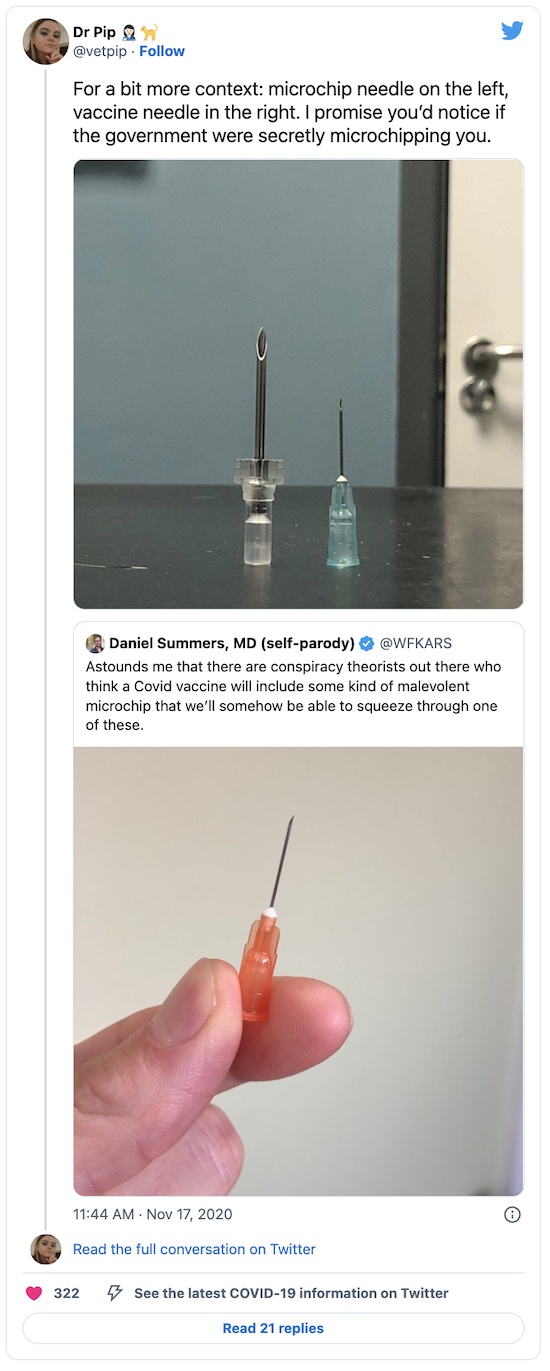
Gestae Commentaria
Comments for this post are closed pending repair of the comment system, but the Email/Twitter/Mastodon icons at page-top always work.